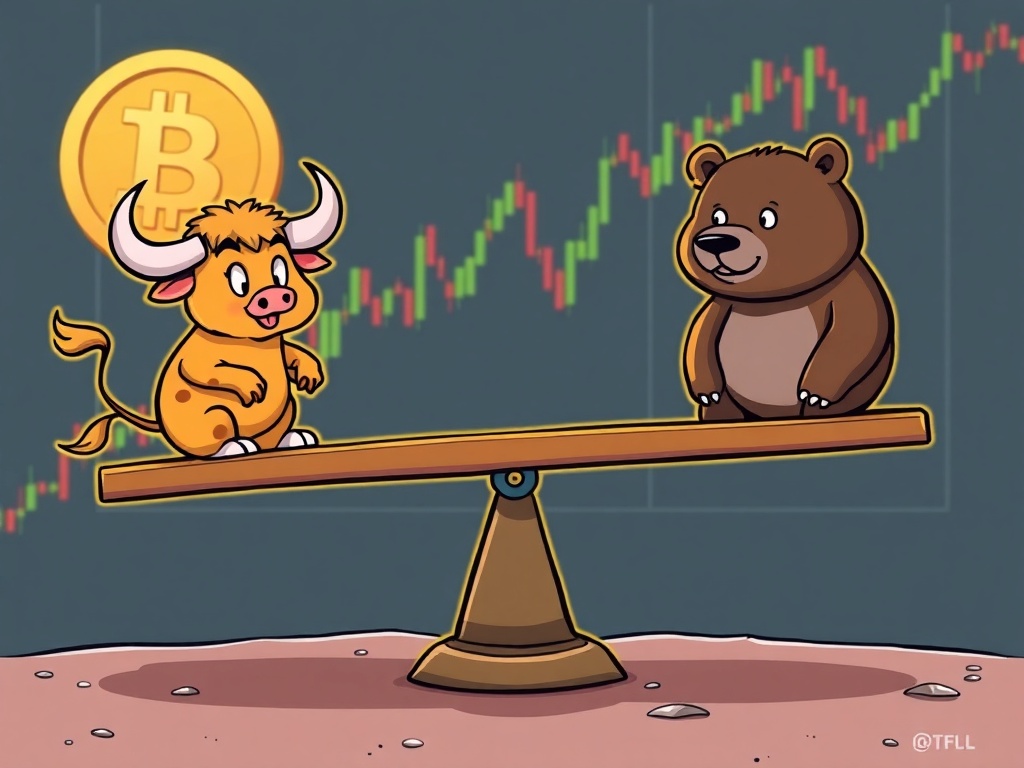BitcoinWorld

Bitcoin Long-Short Ratios: Unveiling Crucial Market Sentiments for Astute Traders
In the dynamic and often unpredictable world of cryptocurrency, understanding market sentiment is paramount. While price charts and technical indicators offer valuable insights, a deeper dive into trader positioning can reveal underlying biases that often precede significant market moves. One such powerful, yet frequently overlooked, indicator is the BTC long-short ratios for perpetual futures.
These ratios provide a direct snapshot of how traders are positioning themselves on derivatives exchanges, indicating whether the collective sentiment leans bullish (long) or bearish (short). For anyone looking to navigate Bitcoin’s volatile landscape with greater precision, grasping the implications of these ratios is not just an advantage, it’s a necessity.
What Do BTC Long-Short Ratios Really Tell Us?
At its core, a long-short ratio is a simple yet profound metric. It represents the proportion of traders holding ‘long’ positions (betting on a price increase) versus those holding ‘short’ positions (betting on a price decrease) on a given cryptocurrency perpetual futures contract. When you see the BTC long-short ratios, you’re essentially getting a pulse check on the market’s immediate expectations for Bitcoin.
A ratio above 1 typically indicates a predominance of long positions, suggesting bullish sentiment. Conversely, a ratio below 1, or more specifically, a higher percentage of short positions as seen in our recent data, points towards a bearish outlook. For instance, let’s examine the 24-hour data for BTC perpetual futures across leading exchanges:
| Category | Long Percentage | Short Percentage |
|---|---|---|
| Total Market | 48.16% | 51.84% |
| Binance | 47.88% | 52.12% |
| Bybit | 47.39% | 52.61% |
| Gate.io | 46.18% | 53.82% |
As the table clearly illustrates, over the past 24 hours, the aggregate market for BTC perpetual futures has shown a slight bearish bias, with short positions outweighing long positions. This trend is consistently reflected across major exchanges like Binance, Bybit, and Gate.io, indicating a widespread sentiment rather than an isolated anomaly.
Why Are BTC Long-Short Ratios a Crucial Indicator for Astute Traders?
Understanding BTC long-short ratios goes beyond just knowing who’s betting what. It offers several critical advantages for traders seeking an edge:
- Gauging Market Sentiment: This is the most direct benefit. The ratios provide an immediate understanding of whether the crowd is leaning bullish or bearish. This insight is invaluable for confirming your own analysis or identifying potential contrarian opportunities. If everyone is overwhelmingly long, it might signal an overcrowded trade susceptible to a correction.
- Identifying Potential Reversals: Sometimes, extreme long-short ratios can act as contrarian indicators. If the market is overwhelmingly short, for example, it might be ripe for a ‘short squeeze’ where price rises rapidly, forcing short sellers to buy back their positions and fueling further upward momentum. Conversely, an excessively long market can be vulnerable to a ‘long squeeze’ or significant correction.
- Complementing Other Indicators: While powerful, BTC long-short ratios are best used in conjunction with other technical and fundamental analysis tools. They can confirm trends identified by price action, volume, or on-chain data, adding an extra layer of conviction to your trading decisions.
- Assessing Market Crowdedness: A highly skewed ratio indicates a crowded trade. Entering a trade where the majority is already positioned can be risky, as it leaves less room for further movement in that direction and increases the likelihood of a sharp reversal if sentiment shifts.
By integrating this data into your analysis, you move beyond just looking at price and volume, gaining a deeper understanding of the collective psychological state of the market participants.
How Do Exchange-Specific BTC Long-Short Ratios Offer Unique Insights?
While the overall market BTC long-short ratios provide a general overview, looking at individual exchanges offers a more nuanced perspective. As seen in our data:
- Binance: Long 47.88%, Short 52.12%
- Bybit: Long 47.39%, Short 52.61%
- Gate.io: Long 46.18%, Short 53.82%
Notice that all three top exchanges exhibit a similar bearish leaning over the 24-hour period, with short positions slightly outnumbering long positions. However, there are subtle differences. Gate.io, for instance, shows a slightly more pronounced bearish bias compared to Binance or Bybit.
These variations can be attributed to several factors:
- User Demographics: Different exchanges attract different types of traders. Some might have a higher concentration of retail traders, while others might cater more to institutional players or experienced derivatives traders.
- Liquidity and Trading Volume: Exchanges with higher liquidity and volume might present a more accurate reflection of the broader market, while smaller exchanges could show more volatile or idiosyncratic ratios.
- Trading Products and Features: Unique features or product offerings on certain exchanges might influence how traders position themselves.
Monitoring these exchange-specific ratios can help you identify if a particular sentiment is widespread or concentrated on a single platform, providing a more comprehensive view of the market’s conviction.
What Are the Pitfalls of Relying Solely on BTC Long-Short Ratios?
While invaluable, it’s crucial to understand that BTC long-short ratios are not a crystal ball and should never be used in isolation. Like any single indicator, they have limitations:
- Snapshot vs. Trend: A 24-hour ratio is a snapshot. While useful, it doesn’t tell the whole story of how sentiment has evolved over days or weeks. Observing the trend of the ratio is often more insightful than a single data point.
- Whale Activity: Large institutional or ‘whale’ trades can significantly skew the ratios temporarily, making it appear as if sentiment has shifted dramatically when it might just be one large player opening or closing a position.
- Context is Key: A high short ratio might seem bearish, but if it’s accompanied by strong buying volume and a breakout from a resistance level, the shorts might be getting squeezed, leading to an upward move. Always consider the broader market context, including macroeconomic news, Bitcoin halving cycles, or regulatory developments.
- Funding Rates and Open Interest: These are related metrics that provide additional context. High negative funding rates combined with a high short ratio, for example, can indicate extreme bearishness and potential for a short squeeze.
Therefore, successful traders integrate this data with a holistic market analysis approach, combining it with technical analysis, on-chain data, and fundamental news.
How Can You Leverage BTC Long-Short Ratios for Smarter Trading Decisions?
Now that we understand the ‘what’ and ‘why’, let’s explore the ‘how’ – practical ways to integrate BTC long-short ratios into your trading strategy:
- Look for Extremes and Reversals: Pay close attention when the ratios become significantly skewed. For example, if short positions reach unusually high levels (e.g., 60-70% or more), it could signal that the market is overly bearish and a short squeeze might be imminent. Conversely, extremely high long positions could precede a correction.
- Combine with Funding Rates: Funding rates on perpetual futures contracts are payments exchanged between long and short positions. If the funding rate is negative (shorts pay longs) and the short ratio is high, it reinforces a strong bearish sentiment, potentially setting the stage for a reversal.
- Confirm Technical Signals: Use the ratios to confirm signals from your technical analysis. If you see a bullish divergence on the RSI and the BTC long-short ratios start shifting from heavily short to more balanced, it adds conviction to a potential long entry.
- Gauge Liquidation Risk: A highly concentrated position (either long or short) increases the risk of liquidation cascades. If a market is overwhelmingly long, a small price dip can trigger a cascade of liquidations, driving the price down further. Being aware of this helps manage your risk exposure.
- Observe Trends, Not Just Snapshots: Don’t make decisions based on a single 24-hour reading. Track how the ratios evolve over several days or even weeks. Is the bearish bias strengthening or weakening? Is there a consistent shift in sentiment?
By adopting a disciplined approach and using these ratios as one piece of a larger puzzle, you can significantly enhance your ability to read the market and make more informed, profitable trading decisions in the dynamic Bitcoin market.
In conclusion, BTC long-short ratios for perpetual futures offer a powerful lens into the collective sentiment of the cryptocurrency market. They provide crucial insights into whether traders are predominantly bullish or bearish, helping to identify potential turning points, confirm trends, and manage risk effectively. While the recent 24-hour data points to a slight bearish bias across major exchanges, remember that these ratios are most effective when combined with other analytical tools and a comprehensive understanding of market dynamics. By integrating this valuable data into your trading arsenal, you empower yourself to navigate Bitcoin’s volatile currents with greater confidence and strategic foresight, ultimately enhancing your potential for success.
Frequently Asked Questions (FAQs)
What is a BTC perpetual future?
A BTC perpetual future is a type of derivatives contract that allows traders to speculate on the future price of Bitcoin without actually owning the underlying asset. Unlike traditional futures, perpetual futures do not have an expiry date, meaning they can be held indefinitely. They are popular for leverage trading and hedging.
What does a high short percentage in BTC long-short ratios mean?
A high short percentage (e.g., above 50% or significantly higher) indicates that more traders are betting on a decrease in Bitcoin’s price. It reflects a bearish sentiment in the market. While this often suggests potential downside, extremely high short percentages can sometimes precede a ‘short squeeze,’ where a price increase forces short sellers to buy back, fueling further upward momentum.
Are BTC long-short ratios always accurate predictors of price movement?
No, BTC long-short ratios are not always accurate predictors on their own. They are a sentiment indicator and should be used in conjunction with other technical analysis tools (like volume, price action, support/resistance levels) and fundamental analysis (news, macroeconomic factors). Market sentiment can shift rapidly, and large trades can temporarily skew ratios.
How often should I check these ratios for effective trading?
The frequency depends on your trading style. For day traders, checking hourly or every few hours might be beneficial. Swing traders might prefer daily or even weekly checks to identify broader trends. It’s more important to observe the trend and significant shifts in the ratios rather than just focusing on single data points.
Which exchanges are best for checking BTC long-short ratios?
Major derivatives exchanges like Binance, Bybit, and Gate.io (as highlighted in our data) are good sources for checking these ratios, as they typically have high liquidity and trading volume, providing a more representative view of the market. Many crypto analytics platforms also aggregate this data from various exchanges.
If you found this article insightful, consider sharing it with your fellow crypto enthusiasts and traders on social media! Your shares help us continue providing valuable market analysis and educational content.
To learn more about the latest Bitcoin market trends, explore our article on key developments shaping Bitcoin price action.
This post Bitcoin Long-Short Ratios: Unveiling Crucial Market Sentiments for Astute Traders first appeared on BitcoinWorld and is written by Editorial Team





